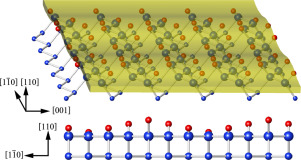当前位置:
X-MOL 学术
›
Surf. Sci.
›
论文详情
Our official English website, www.x-mol.net, welcomes your
feedback! (Note: you will need to create a separate account there.)
Anisotropic surface phonon dispersion of a deuterium-terminated Si(110)-(1 × 1) surface studied by high-resolution electron-energy-loss spectroscopy and first-principles calculations: isotope effect
Surface Science ( IF 2.1 ) Pub Date : 2020-02-01 , DOI: 10.1016/j.susc.2019.121527 Erina Kawamoto , Stephane Yu Matsushita , Yuta Okada , Chunping Hu , Kazuyuki Watanabe , Kenya Haga , Taro Yamada , Shozo Suto
Surface Science ( IF 2.1 ) Pub Date : 2020-02-01 , DOI: 10.1016/j.susc.2019.121527 Erina Kawamoto , Stephane Yu Matsushita , Yuta Okada , Chunping Hu , Kazuyuki Watanabe , Kenya Haga , Taro Yamada , Shozo Suto

|
Abstract The surface phonon dispersion of a deuterium-terminated Si(110)-(1 × 1) surface [D:Si(110)-(1 × 1)] is investigated by using high-resolution electron-energy-loss spectroscopy (HREELS) and first-principles calculations based on the density functional theory (DFT) with the local density approximation (LDA). The characteristics of D:Si(110)-(1 × 1) are unique compared to those of H:Si(110)-(1 × 1) (Matsushita et al., 2015) in terms of the resolved vibrational modes. By the HREELS, one-dimensional surface phonons consisting of D–Si stretching vibrations are observed above the bulk-phonon band energy edge of 64.5 meV. Ten modes are observed below this value, classified as surface, surface resonant, and bulk phonons according to the calculated energy dispersion as well as the depth profile of spectral density and displacement vectors. In particular, five D–Si bending modes are observed out of the seven theoretically predicted modes. The bending modes are strongly coupled with the displacements across the D and five Si layers. The DFT-LDA surface phonon dispersion is in good agreement with the experimental results except a few frequency/dispersion mismatches, as the structure optimized by DFT-LDA mismatches with the previous scanning tunneling microscopy (STM) results (Matsushita et al., 2015). D:Si(110)-(1 × 1) elucidates the nature of covalently bonded phonons and their characteristics both experimentally and theoretically.
中文翻译:

通过高分辨率电子能量损失光谱和第一性原理计算研究的以氘为末端的 Si(110)-(1 × 1) 表面的各向异性表面声子色散:同位素效应
摘要 利用高分辨率电子能量损失谱 (HREELS) 研究了以氘为末端的 Si(110)-(1 × 1) 表面 [D:Si(110)-(1 × 1)] 的表面声子色散) 和基于密度泛函理论 (DFT) 和局部密度近似 (LDA) 的第一性原理计算。D:Si(110)-(1 × 1) 的特征与 H:Si(110)-(1 × 1)(Matsushita 等人,2015)相比,在解析振动模式方面是独一无二的。通过 HREELS,在 64.5 meV 的体声子带能量边缘上方观察到由 D-Si 伸缩振动组成的一维表面声子。根据计算的能量色散以及光谱密度和位移矢量的深度分布,在此值以下观察到十种模式,分为表面、表面共振和体声子。特别是,在七个理论上预测的模式中观察到了五个 D-Si 弯曲模式。弯曲模式与跨 D 层和五个 Si 层的位移密切相关。除了少数频率/色散不匹配外,DFT-LDA 表面声子色散与实验结果非常吻合,因为 DFT-LDA 优化的结构与之前的扫描隧道显微镜 (STM) 结果不匹配(Matsushita 等,2015) . D:Si(110)-(1 × 1) 从实验和理论上阐明了共价键合声子的性质及其特性。除了少数频率/色散不匹配外,DFT-LDA 表面声子色散与实验结果非常吻合,因为 DFT-LDA 优化的结构与之前的扫描隧道显微镜 (STM) 结果不匹配(Matsushita 等,2015) . D:Si(110)-(1 × 1) 从实验和理论上阐明了共价键合声子的性质及其特性。除了少数频率/色散不匹配外,DFT-LDA 表面声子色散与实验结果非常吻合,因为 DFT-LDA 优化的结构与之前的扫描隧道显微镜 (STM) 结果不匹配(Matsushita 等,2015) . D:Si(110)-(1 × 1) 从实验和理论上阐明了共价键合声子的性质及其特性。
更新日期:2020-02-01
中文翻译:

通过高分辨率电子能量损失光谱和第一性原理计算研究的以氘为末端的 Si(110)-(1 × 1) 表面的各向异性表面声子色散:同位素效应
摘要 利用高分辨率电子能量损失谱 (HREELS) 研究了以氘为末端的 Si(110)-(1 × 1) 表面 [D:Si(110)-(1 × 1)] 的表面声子色散) 和基于密度泛函理论 (DFT) 和局部密度近似 (LDA) 的第一性原理计算。D:Si(110)-(1 × 1) 的特征与 H:Si(110)-(1 × 1)(Matsushita 等人,2015)相比,在解析振动模式方面是独一无二的。通过 HREELS,在 64.5 meV 的体声子带能量边缘上方观察到由 D-Si 伸缩振动组成的一维表面声子。根据计算的能量色散以及光谱密度和位移矢量的深度分布,在此值以下观察到十种模式,分为表面、表面共振和体声子。特别是,在七个理论上预测的模式中观察到了五个 D-Si 弯曲模式。弯曲模式与跨 D 层和五个 Si 层的位移密切相关。除了少数频率/色散不匹配外,DFT-LDA 表面声子色散与实验结果非常吻合,因为 DFT-LDA 优化的结构与之前的扫描隧道显微镜 (STM) 结果不匹配(Matsushita 等,2015) . D:Si(110)-(1 × 1) 从实验和理论上阐明了共价键合声子的性质及其特性。除了少数频率/色散不匹配外,DFT-LDA 表面声子色散与实验结果非常吻合,因为 DFT-LDA 优化的结构与之前的扫描隧道显微镜 (STM) 结果不匹配(Matsushita 等,2015) . D:Si(110)-(1 × 1) 从实验和理论上阐明了共价键合声子的性质及其特性。除了少数频率/色散不匹配外,DFT-LDA 表面声子色散与实验结果非常吻合,因为 DFT-LDA 优化的结构与之前的扫描隧道显微镜 (STM) 结果不匹配(Matsushita 等,2015) . D:Si(110)-(1 × 1) 从实验和理论上阐明了共价键合声子的性质及其特性。











































 京公网安备 11010802027423号
京公网安备 11010802027423号